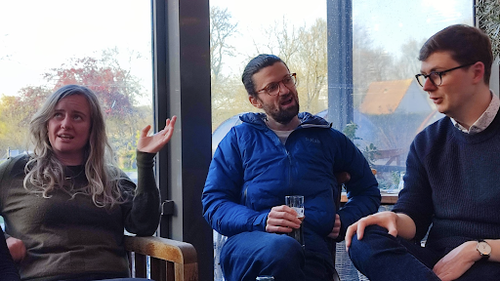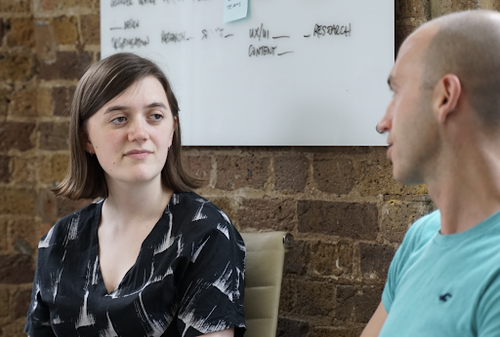Our core values are very important to us at Unboxed. Healthier Relationships and Care and Attention play a big part in how we communicate and relate to each other and to our clients. Connecting and communicating well are how we create healthy relationships and how we manage our wellbeing. While a big focus in communication is how we talk to and behave with each other, the more undervalued element of communication is listening.
We live in a world where our own opinions are most important, where talking, shouting and making ourselves heard is king and a “cancel culture” means we stop listening to people who we don’t agree with. Amidst the drive for constant communication and a cacophony of noise some suggest that we are losing the art of listening. There’s too much noise (both physical and psychological), our attention spans are shorter and we increasingly live and work at pace. When we stop really listening we stop understanding each other, allowing divisions and discord to flourish.
Researchers in the UK and the USA have warned of a growing epidemic of loneliness. In 2018 Theresa May appointed a Minister for Loneliness and launched a cross government strategy to tackle it. In a hyper connected world, people are increasingly isolated, significantly raising the risk of public health issues such as heart disease, dementia and premature death. Nearly 3 years of a global pandemic has certainly not helped this situation. But to combat loneliness it’s not just a case of “getting out there” and seeing people, we can still be lonely in the company of others. People don’t necessarily want to talk, but they do want and need to be listened to.
Sounds easy right? And we probably all think we listen and listen well. But in reality it’s harder to do than we think. So listening and listening consciously is a skill we need to value, have as an equal part of our communications tool kit and we need to practice it in order to get the best from people at work and to keep our wellbeing in balance.
What does listening well mean?
“Active listening does not necessarily mean long sessions spent listening to grievances, personal or otherwise. It is simply a way of approaching those problems which arise out of the usual day-to-day events of any job.” Carl R. Rogers and Richard E. Farson
Carl R. Rogers and Richard E. Farson founded the concept of active listening in 1957 and while it was initiated in the therapy room, active listening is something that can be applied to our workplace relationships as well as our personal ones. It can help us understand our clients', users' and colleagues' needs, problems and desires.
Active listening means to listen attentively. It's the practice of preparing to listen, to observe verbal and non-verbal messages, to demonstrate attentiveness and provide appropriate feedback. It shows a mutual understanding between the speaker and the listener, where the speaker knows they are being consciously listened to, and the listener is absorbing the information and understanding it in an engaged way.

If you ask yourself the question “have you ever listened to someone, only to realise you were planning your response the entire time?” it will no doubt resonate. Listening is more than the passive act of receiving or hearing. It is an active process. We may believe that we are good listeners but all too often we listen to others through the lens of our own thoughts and feelings. We may jump in with our own opinions and experiences, daydream or be judging what the person is saying. We aren’t really exploring what the person is saying, we’re not being empathic. This results in the speaker not feeling heard, or worse, put on the defensive. So it takes some conscious effort and practice to listen attentively and remove yourself from the conversation.
How to listen attentively
- Listen for total meaning - this means listening to the content of the message and the feeling or attitude underlying the message. For example if one of your colleagues says to you “I’ve finished that set of designs” it is a very different message to if they say “ Well, I’ve finally finished those stupid designs”. The content is the same but the meaning is very different and your response will be different to each
- Respond to feelings - sometimes the content of the message is less important than the feelings which underlie it. There are various shades of feelings around what is being said which are important to pay attention to. The questions to ask yourself are “What are they actually trying to tell me?” “What does this mean to them?”
- Note all cues - a standard formula often gets used when talking about the amount of non-verbal cues there are when we communicate. The 55/38/7 formula refers to 55% of communication as body language; 38% as tone of voice and 7% is the actual words spoken. While this may not be an exact formula it does give us a good idea of how much of what we communicate is not necessarily the words we speak. So to listen attentively it’s important to pay equal attention to body language, tone of voice, and facial expression
- Restatement or paraphrase - paraphrasing or restating what someone has said, demonstrates that you have heard and understood what has been said. It doesn’t mean parroting back someone’s words
- Ask questions - try to resist the impulse to tell your own story, instead ask open questions e.g. “What does this mean for you?” These are powerful tools for deepening conversations and understanding
- Tolerating a silence - we don’t find silence comfortable so trying to resist the urge to fill a silence allows the space for deeper reflection. Filling a silence may mean cutting off something valuable that needed space to come to light
- Consider body language - as the person listening it’s important also to think about our body language. Is our body language open? Do we look like we’re listening? Not distracted and looking elsewhere? Our own body language is as important when we are actively listening as it for the person talking
By consistently listening in this way you are conveying to the speaker that you are interested in them as a person and in what they have to say. If we are able to employ this skill in both the workplace and our personal lives we will be much better equipped to understand our colleagues and clients needs, and those of our loved ones.
Challenges with active listening
Attentive listening takes practice, it’s not easy and it may involve changing some aspect of ourselves! To be an effective listener, we need to have a sincere interest in the speaker. We tend to see things through our own desires, thoughts and experiences, which really makes it a challenge to fully pay attention to someone else.
To understand the meaning that something has for someone and their experience, means seeing something as they do, and not as you might. So there can be personal risk if feeling what someone else is experiencing is uncomfortable or distressing. It takes some inner strength and security in order to be able to risk oneself in order to understand another.
And it is difficult to free yourself from your own world view, experience, thoughts and feelings in order to be present for someone else. It’s sometimes not comfortable either, but it is a challenge.
But if we are willing to risk ourselves, by seeing the world through someone else's experiences then we are also enriched and enabled to better understand complex problems and help to find solutions. Good listening is really a type of behaviour we can all practice and as with many behaviours it’s contagious. If someone feels properly listened to they are more likely to be open and honest and to speak what they really think and feel about something. So in the workplace, how is this so helpful?
Why it’s important in the workplace and where we can use it

So now we know what listening attentively is and why it’s a good thing. So how and where can we use it at work?
In terms of how productive we are, active listening plays a big role in the workplace. If employers fail to properly listen to employees they risk losing them. It’s part of a trusting and caring relationship which means employees feel valued, cared about and motivated. An environment that allows people to be open and honest and feel listened to, they will be more energised, fulfilled and focussed. It should be easier to raise problems earlier and deal with any resentment or difficulties. And it’s about how we work with each other and with our clients, user and stakeholders.
User research and design
For our user researchers and designers, properly understanding what the problems are for users means really listening to what they are telling them. It’s a real skill to be able to listen attentively to someone, to try and understand their point of view and experience, particularly in a short space of time while having to think about the next question. But in that exchange so much valuable information can be gained to really hear and understand what causes people’s difficulties in order to find better solutions.
Understanding clients needs and complex problems
Really trying to understand a client's needs, often means working with a range of stakeholders, listening well to the complex problems they want us to solve together. Paying full attention and listening well demonstrates both a sincere interest in the person and the problem, enabling a richer, more productive conversation and environment in which to work through the problems to find a good solution.
Team Collaboration
Working collaboratively in a multidisciplinary team with developers, designers, delivery managers and clients, means lots of voices, needs and ideas. It’s a challenging environment for all to be heard and understood. Listening well to what people are saying means understanding better issues that arise
Personal development and reflection
An important aspect of our work is our own personal development and reflection. Our monthly reflection sessions provide an important opportunity to listen to individuals, to hear how their month has been, what’s gone well and what’s been a challenge. We’ve discovered that these were the sessions that people didn’t know they needed!
These are just some of the more specific examples of opportunities to use or practice active or attentive listening to others in the workplace. But it can also happen in day to day communication over a coffee or lunch if we are alive to listening well. One of the challenges for remote and hybrid working is that we can’t really see each other through the screen. We can hear what people are saying and we can see people’s faces but the subtleties and nuances of body language are easily missed. This is something that we need to be mindful of and think about as we continue to adapt to hybrid styles of working.
I’ll leave Rogers and Farson summarise this process in the most succinct way possible:
By consistently listening to a speaker, you are conveying the idea that: “I’m interested in you as a person, and I think that what you feel is important. I respect your thoughts, and even if I don’t agree with them, I know that they are valid for you. I feel sure that you have a contribution to make. I’m not trying to change you or evaluate you. I just want to understand you. I think you’re worth listening to, and I want you to know that I’m the kind of a person you can talk to.”

